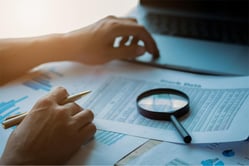Forensic Investigations: The Ins and Outs of Questioned Document Examinations
 Forensic investigations almost inevitably require documentary evidence to be examined. Experts often look beyond the content of documents. They also may consider physical and latent evidence — such as handwriting, alterations, and faded or decomposed material.
Forensic investigations almost inevitably require documentary evidence to be examined. Experts often look beyond the content of documents. They also may consider physical and latent evidence — such as handwriting, alterations, and faded or decomposed material.
Mission-critical objectives
Forensic experts may follow questioned document examination procedures to analyze a disputed document using scientific processes and methods. These examinations can produce a wealth of evidence that a layperson could easily miss. For example, an expert can examine and compare documents to:
- Establish genuineness, expose forgery or reveal alterations,
- Identify or eliminate individuals as the source of handwriting,
- Identify or eliminate the sources of printing or other impressions, marks or relative evidence,
- Write reports or give testimony, and
- Aid the users of the examiner’s services in understanding the examiner’s findings.
The expert applies both technology and subjective interpretation, based on training and experience, to accomplish these objectives.
Requested vs. nonrequested standards
Typically, a forensic expert examines a questioned document and compares it with known documents referred to as “standards.” The similarities and differences between the standards and questioned documents form the basis for the expert’s conclusions.
Standards generally fall into one of two categories:
- Requested. The individual is instructed to write the exact words desired. These standards, however, are vulnerable to distortions by the individual.
- Nonrequested. These standards are writings executed in the normal course of events, without knowledge of their future use for questioned document examination procedures. Although they’re not subject to willful distortions, nonrequested standards may not contain the exact words or phrases an expert is seeking.
Ideally, an expert can compare like documents or shared components, such as cursive or particular phrases used in both. If the same words or phrases don’t appear in both, the expert likely will require a greater volume of standards and more analysis to reach conclusions. If the expert can reach a conclusion, he or she will provide it on a scale, usually ranging from “positively identified” to “eliminated.”
Technological tools
Experts use different types of technology to detect changes to documents and to retrieve or recover evidence. An electrostatic detection apparatus, for example, detects invisible indentations on questioned documents based on microscopic damage on their surface. Such a discovery could indicate that a notation on a document was added at a different time than claimed. In some cases, this technology is used to determine the age of the document.
An expert also might use a spectral comparator. Video spectral comparators enable examiners to analyze inks and watermarks, visualize hidden security features, and uncover alterations and obliterations on a document. The main purpose of a Raman spectral comparator is to compare ink samples to determine whether they match based on shared spectral characteristics.
Team effort
Of course, forensic experts aren’t solely responsible for successful evidence testimony. Attorneys and clients can bolster their experts’ testimony by maintaining document integrity. If possible, you should avoid folding, cutting, stapling or making notes on documentary evidence. Above all, it’s important to preserve the chain of custody. Contact your forensic accounting expert for more information.
© 2021








